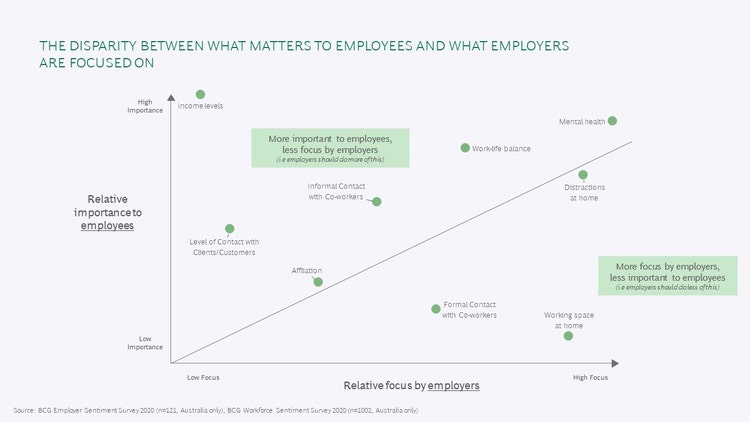Working from home or living at work? How to support and engage your hybrid workforce

With more and more organisations embracing hybrid work as the way of the future, how can employees stay connected in a meaningful way from their chosen workspace? We explore three strategies for HR leaders looking to successfully engage with a remote workforce.
The traditional model of working in an office as the norm and remote working as the exception has been turned on its head. In fact, research shows two thirds (66%) of Australian employers are now supporting greater levels of remote working and over one third (38%) plan to offer remote working to all employees1.
This shift to remote working is also being driven by employees and their preferences. In their May 2020 survey of over 1,000 Australians, Boston Consulting Group found 85% of those who can work remotely, want to do so2. But most of this group still want to be in the office some of the time, with a two/three day split across both locations emerging as the most popular hybrid option.
With more and more people switching between days working from home (WFH) and onsite, organisations are challenged to make this hybrid model a win-win for both employers and employees. For HR teams this means rethinking the employee engagement model and how to cultivate a culture that fosters wellbeing and, ultimately, retention among their workforce.
The impact of WFH: perception vs reality
With employees working from home at least some of the time, organisations are dealing with the challenges of workplace isolation, a lack of visibility for both employers and employees and limited opportunities for face-to-face communication. Yet, while employers may be acknowledging and addressing these issues to some extent, research suggests there is a gap between where they are focusing their efforts and what employees actually want and need3.

Source: Boston Consulting Group, Employer Sentiment Survey 2020, (n=121, Australia only), Boston Consulting Group, Workforce Sentiment Survey 2020, (n=1002, Australia only)
By moving past assumptions about what employees need to thrive and stay productive while working from home, organisations can channel their time and resources into more effective ways of maintaining employee engagement and wellbeing, as well as reaping the benefits of collaboration and innovation. Here are 3 strategies for HR leaders to consider:
1. Make time for informal contact to boost employee motivation, connection and innovation
Quite naturally many organisations have prioritised getting the mechanics of working from home up and running. Having the right technology in place to support formal working practices has been a priority. However, the next important phase in evolving WFH arrangements is to find ways to create a greater sense of connection in a virtual workspace.
According to global research conducted at the height of the pandemic in 2020, 80% of Australian workers missed the social side of work4 and the associated impacts of this isolation on mental health have been widely reported. But the risks of disconnection from co-workers go beyond the wellbeing of employees. In their 2021 Work Trend Index: Annual Report, Microsoft found that weaker workplace connections resulting from the #WFH trend are leading to a decrease in activities that lead to innovation, such as thinking strategically (–9%), collaborating or brainstorming with others (–10%), and proposing new ideas (–9%).
To create more opportunities for connection and collaboration for employees WFH, here are some activities to try:
- Create a committee for an employee angle on engagement – setting up a volunteer committee that meets regularly to review virtual engagement initiatives and brainstorm ideas for new ones can help you learn which activities employees are getting the most from and which are getting tired or stale.
- Host virtual team bonding activities – although harder to organise at a distance, virtual team activities work wonders for helping employees get to know one another in a more casual setting, helping them feel more connected to your organisation and one another. For something different, dip into this list of ideas and try things like spreadsheet pixel art or five finger showdown with your team.
- Create ‘water cooler’ moments – setting up informal channels sanctioned for non-work conversations can make way for important moments of connection. According to Microsoft Senior Principal Researcher Dr Nancy Baum who has studied social connections for decades, it’s these moments that foster creativity and innovation “They build trust, they discover common interests they didn’t know they had and they spark ideas and conversations,” she says.
“When you lose connections, you stop innovating. There are no new ideas getting in and groupthink becomes a serious possibility.”
Dr. Nancy Baym, Senior Principal Researcher at Microsoft 2021 Work Trend Index: Annual Report
2. Reinforce the value of financial benefits you provide
At a time when employees are at greater risk of feeling disconnected and disengaged, employee benefits have the potential to be a critical value-add for your workforce. With limited wage growth there are also few opportunities for organisations to acknowledge, reward and retain employees. Higher engagement with benefits such as salary packaging and rewards/discounts can improve employees’ financial and lifestyle outcomes, which, in turn, adds to the overall value they realise from their work. And with 70% of employees saying they spend time worrying about their finances at work, these savings can be an important part of a successful HR strategy to support financial wellbeing for their workforce.
There are a number of ways for HR teams to boost engagement with employee benefits programs, including:
- Drive greater value – maximise participation and employee engagement with your Employee Value Proposition with easy take-up of salary packaging, rewards and other benefits during induction.
- Enhance access and education – provide self-service access to relevant information so employees can better understand value they’ll get from benefits, in particular salary-packaging which is often not well-understood.
- Offer personalisation and support – deliver personalised content across benefits promotion campaigns and offers, including call centre support, to guide employees in optimising their benefits and salary-packaging choices.
3. Keep an eye on work life balance to limit mental health problems and ‘culture decay’
If employers had expected employees to be less productive working remotely, the switch to WFH during COVID-19 has had the opposite result. In their 2021 Work Trend Index Report, Microsoft compared data from Teams software use from February 2020 and February 2021. They found that the average user is sending 45% more chats per week and 42% more chats after hours5. This global trend of working around the clock has also been reported by Australian workers, with 56% finding it harder to shut off from work outside their normal hours4.
This inability to ‘switch off’ can lead to a phenomenon leaders are calling ‘culture decay’. This is where an increase in remote working reduces social interaction and introduces a blurring of boundaries between work and other responsibilities, leading to negative outcomes for employees’ mental health.
Employers can be doing more to make sure the lines between work and home life remain healthy by:
- Leading by example – ensure that leaders at every level of the organisation are sending a clear message about wellbeing and work/life balance being a priority for all. Whether it’s the CEO including this topic in a regular video update to employees or managers self-reporting to their teams on their own practice of disconnecting from work responsibilities, regular, high-profile communication can help employees get their own priorities right.
- Making wellbeing a standing item for internal communications – to reinforce communication from leaders, include practical and actionable content with a work/life balance and wellbeing focus in internal communications and as part of workplace training and education programs.
- Encourage employees to self-assess their wellbeing and make a plan – giving employees a tool to regularly self-assess their wellbeing and take steps to make improvements helps them to take responsibility for adopting healthier habits in their work and personal life, such as more time spent on exercise and less on digital devices.
As a premium provider of employees benefits to many organisations across Australia, Maxxia have seen the difference salary packaging can make to the overall financial position of employees. Not only can take up of salary packaging potentially boost net household income for employees, a best-practice program supported by effective communication can also strengthen your employee value proposition as a whole.
Maxxia can offer your organisation a full benefits assessment to measure the effectiveness of your current employee benefits offer. We can also put a dollar figure to the potential savings and efficiencies from running the program and compare overall performance with best practice for your industry.
1. Telstra/Omdia Future of Work survey, July 2020, https://www.telstra.com.au/business-enterprise/news-research/research/omdia-corporate-dna-report
2. Boston Consulting Group, Personalisation for your people How COVID-19 is reshaping the race for talent, June 2020, https://image-src.bcg.com/Images/ANZ-Personalisation-for-your-people_tcm9-251462.pdf.
3. Boston Consulting Group, The expectation gap in the future of work employee vs. employer sentiment and the emerging division of Australian organisations, December 2020, https://www.bcg.com/en-au/publications/2020/understanding-the-expectation-gap-in-the-future-of-work-australia
4. Asana, Asana Anatomy of Work: Remote Teams Survey Reveals Two-Thirds of Global Employees Embracing Collaboration Tools, 29 April 2020, https://asana.com/press/releases/pr/asana-anatomy-of-work-remote-teams-survey-reveals-two-thirds-of-global-employees-embracing-collaboration-tools/34843f90-7760-49cd-9d1b-fdb305a8f4b1
5. Microsoft, 2021 Work Trend Index: Annual Report, https://www.microsoft.com/en-us/worklab/work-trend-index/hybrid-work
Related articles
Unlock maximum value from your employee benefits program
Interested to find out more? Fill in your details below.